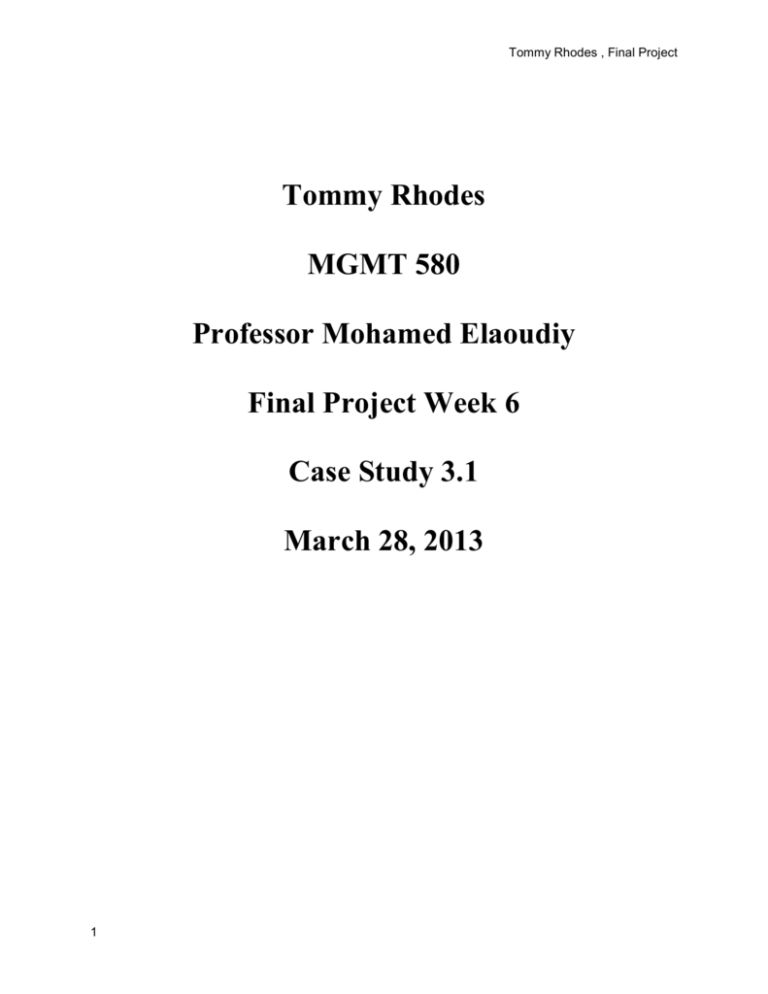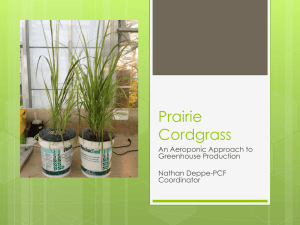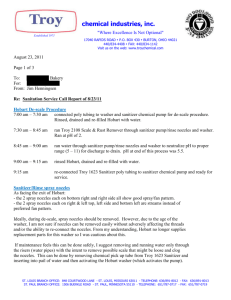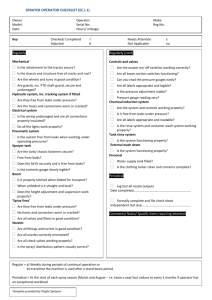
Tommy Rhodes , Final Project
Tommy Rhodes
MGMT 580
Professor Mohamed Elaoudiy
Final Project Week 6
Case Study 3.1
March 28, 2013
1
Tommy Rhodes , Final Project
Problem Statement
Our problem solving team must determine the cause(s) of the clogged nozzles in the
automatic parts washer. In order for us to know if the right changes have been made to the
process, we must develop the appropriate metrics and key process out put variables, such as,
have we eliminated the issue of the clogged nozzles and how can we implement solutions to
prevent this issue from resurfacing in the future? In order to track these metrics overtime, the
station operator will record and document any issues with the washer or nozzles and submit a
report or any problems or issues to the quality control team for further evaluation. We must also
identify the current baseline performance of the process. WP’s second facility in St. Louis
Missouri has the exact automatic parts washer and this particular facility on has to clean the
nozzles in the automatic parts washer once every six months, which is only due to standard
operating procedures put in place as preventative measures and not due to timely delays.
Therefore we now have a baseline performance of the process. Whatever solution we brainstorm
and implement must at least last approximately six months. The final part of the planning
process is to determine what changes need to be made to the key process input variables in order
to positively affect the key process output variables. However we first need to brainstorm on the
potential cause of the clogged nozzles.
It appears that small particles become clogged in the tiny orifices of the nozzles. We must
brainstorm as to why this may be happening. We have made determined that the particles could
be one or several of the following: hard water build up, calcium deposits, chips from the parts,
paint chips, soap flakes, something caused by chemical reaction, some type of gravel or dirt,
2
Tommy Rhodes , Final Project
erosion of the actual orifices, soap scum build-up, or it could be an irregular temperature of the
water.
We need to start somewhere to determine the cause(s) of the clogged nozzles. We are
going to develop problem solving steps in detail to do so. We know that a significant portion of
the time the nozzles do not spray as freely as they need to in order to properly wash the parts.
Therefore we will allow the process to proceed as normal and when the nozzles clog for the first
time will will stop the process, remove the nozzles, clean the nozzles, retrieve and analyze the
particles which are found inside of the nozzles. With these few steps we hope to determine the
make-up of the particles so that we can then trace the issue back to the source. If we are not able
to determine the make-up of the particles then we must go another route. The small particles
appear to be white and flake like in appearance. Now that the nozzles are out our group
determined it to be to run water through the nozzles for a period of three hours to rule out the
possibility of hard water build up. Since the particles appear to be white flakes we can
reasonably rule out the possible causes such as gravel, dirt, and chips from the parts. Through
process of elimination we can narrow the possible causes down to calcium build-up, soap flakes,
hard water build-up, or a chemical reaction. Upon inspecting nozzles closely we have
determined that we can also rule out the possible cause of erosion of the orifice because the
integrity of the orifice is un-affected. After an extended period of the water test we found that
the nozzle orifices did not become clogged or even particle clogged. Therefore we can now rule
out the possibility of hard water build up.
3
Tommy Rhodes , Final Project
Although we are making progress at determining what the cause(s) may be we have yet
to uncover a definitive answer or solution for the process output. Further questioning of the
operator discloses that the problem occurs most often after the old cleansing solution has been
drained from the tank and new solution put in. With this new information gather we are having
difficulty in determining why this would happen when the new solution is put in. We speculated
among ourselves that the new solution that is placed in the tank could in fact be defective from
the manufacturer and could contain particles in the new batches. Myself and three other group
members proceeded to the storage room to inspect the batches of solution that are stored. We
first expected the “Best Used by Date” on each of the batches to see if they were expired. All of
the batches where in good standing, however one was close to the manufacturers expiration date.
We then visually inspected this batch first to locate any particles. We were unsuccessful in
doing so. We then proceeded to visually inspect the remaining batches of solution but to no
avail. I contacted the manufacturer’s customer service department to inquire about possible
scenarios or factors that may contribute to their product producing white flakey particles. I was
told that they would get back to me as soon as they could with any information they we able to
gather to assist me.
Cause & Effect Diagram 1
4
Tommy Rhodes , Final Project
Meanwhile, we decided to reinstall the nozzles after cleaning them and after replacing the
old solution with new solution. We allowed the normal process to run for two minutes and then
stopped the automatic parts washer to inspect the nozzles. To our surprise the nozzles where
clogged with numerous particles again. After further analyses of these white flakey particles we
were successful in identifying the particles as soap! We must now determine where the soap
particles are coming from.
One of the team members suggested that the tank be drained. After draining the tank we
found the bottom of the tank to be coated with a layer of hard soap. We then retreated back to
the conference room to develop a cause and effect diagram to organize our thoughts. “The
cause-and-effect-diagram is useful in a brainstorming session because it organizes the ideas that
are present (Summers, 2010)”. For the possible issue of nozzle erosion, preventative measures
include monthly inspection for signs of erosion or replace old nozzles with stainless-steel ones to
5
Tommy Rhodes , Final Project
avoid the possibility of erosion all together. For the issue of paint chips, we could check our
process of painting parts to ensure there are no quality defects in the process which would allow
paint chip s to fall off of the parts during wash. Part chips can be an issue as well. Although we
have yet to find part chips as a cause we can still take preventative measures to ensure part chips
will not hold up production. After we make or fabricate the part(s) requested by the customer,
we can be sure to de burr and polish the parts before they are placed into the automatic parts
washer. As for the hard water build up I believe that we do not need to purchase an expensive
water softener system to counter act the hard water build up in the nozzles. Reason being is
periodically we can remove the nozzles to clean them which would save the organization money
as well. This leaves the identified issue of the soap flakes. Now that we have a better
understanding of what the causes are we have decided to draft another cause-and-effect diagram
to better organize the causes of the clogged nozzle orifices.
Cause & Effect Diagram 2
6
Tommy Rhodes , Final Project
Another technique our group will use is called the force-field analysis. “A force-fieldanalysis is a chart that helps teams separate the driving forces and the restraining forces
associated with a complex situation (Summers, 2010)”. We know what the desired solution is
now. We need to incorporate and new filtering system between the tank on the nozzles and
ensure that the temperature of the tank is maintained properly to prevent this issue again. We
will now list the driving forces behind this.
Force-Field-Analysis
Driving Forces
1. Eliminate time delays at the automatic parts wash station
2. Maintain Appropriate tank temperature
3. Research potential vendors for the water filtering system
4. Allocate resources to purchase the water filtering system
5. Train the appropriate staff on how to operate and do routine maintenance on the water filtering
system
Restraining Forces
1. Management has to approve the $10k plus water filtering system purchase
2. There may not be a water filtering system that exist for our particular combination of parts
washer and tank
3. We must troubleshoot why the temperature of the tank is not maintained (human
error/mechanical)
4. Quality team is lacking in this organization (missed the temperature chart to prevent this issue)
5. Water filtering system may have expensive upkeep
7
Tommy Rhodes , Final Project
6. Need to allocate space at the already cramped station for the added equipment
7. Will our engineers maintain the equipment or should we purchase an expensive warranty
Actions
1. Present our findings to management to show a strong need for the potential purchase.
2. Prioritize/Emphasize the water temperature chart for the automatic parts washer.
3. Internally develop and produce our own water filtering systems for the tank
Also, “The why-why diagram is an excellent technique for finding the root cause(s) of a problem
is to ask why five times. This is also an excellent method for determining what factors have to
be in place in order to respond to an opportunity (Summers, 2010)”.
Evaluation of Corrective Actions
8
Tommy Rhodes , Final Project
We have determined that it is reasonable to present upper management with our findings
in hopes of getting approval to purchase this much need piece of equipment. At the minimum
this needs to happen in addition to other corrective actions such prioritizing the water
temperature chart for the automatic parts wash station. It seems that there is a reason to record
the data of the parts washer however no one has been monitoring the information which resulted
in timely delays. I am sure we can prove these timely delays are due the clogged nozzles which
affects the organization’s bottom line to some degree. With that being said the temperature chart
will now be monitored more closely and become a top priority for the employees that work the
automatic parts wash station. Maintaining the appropriate temperature of the tank will no longer
be an issue. WP Inc. is a manufacturer of small parts and tools. Therefore we are not confident
if our engineers possess the ability to research, design, manufacture a water filtering system in a
timely and manor and under cost. Even if our engineers where capable of this, the man hours
and resources used to in the process may far exceed the cost of purchasing the water filtering
system from a vendor. Considering the options it would be wise to focus on convincing upper
management to approve the purchase of the water filtering system for the automatic parts washer
and tank.
Plan of Action to Implement Corrective Actions
We have briefed management of the water temperature issue or the automatic parts
washing station. Management has then briefed the appropriate employees of the importance of
the temperature chart and also mandated that the parts washer station workers check the chart on
an hourly basis to ensure this is no longer an issue. Now that upper management has ok’d the
9
Tommy Rhodes , Final Project
purchase of the brand new water filtering system we will now research and purchase the
appropriate system for our needs and have the vendors install the machinery to ensure it is done
properly. After the machine is installed we will train the appropriate employees on how to
perform routine maintenance on the system to ensure the upkeep. After these corrective actions
have been implemented we will then conduct another evaluation 60 days later to ensure the
appropriate procedures are being followed and to ensure the equipment is functioning as
intended. After the 60 day evaluation it was clear that everything and everyone is in fact
functioning as intended or directed.
References
Summers, D. (2010). Quality. (5th ed.). Upper Saddle River, NJ: Pearson Prentice Hall.
10





